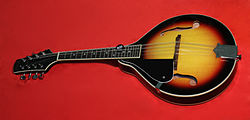Bandolim

An American A-style left-handed mandolin, with F-holes
|
|
| String instrument | |
|---|---|
| Classification | Plucked string instrument |
| Hornbostel–Sachs classification |
321.321-6 (Neapolitan) or 321.322-6 (flat-backed) (Chordophone with permanently attached resonator and neck, sounded by a plectrum) |
| Developed | Mid 18th century from the mandolino |
| Timbre |
varies with the type:
|
| Decay | fast |
| Playing range | |
|
(a regularly tuned mandolin with 14 frets to body)
|
|
| Related instruments | |
varies with the type:
A mandolin (Italian: mandolino pronounced [mandoˈliːno]; literally "small mandola") is a musical instrument in the lute family and is usually plucked with a plectrum or "pick". It commonly has four courses of doubled metal strings tuned in unison (8 strings), although five (10 strings) and six (12 strings) course versions also exist. The courses are normally tuned in a succession of perfect fifths. It is the soprano member of a family that includes the mandola, octave mandolin, mandocello and mandobass.
There are many styles of mandolin, but three are common, the Neapolitan or round-backed mandolin, the carved-top mandolin and the flat-backed mandolin. The round-back has a deep bottom, constructed of strips of wood, glued together into a bowl. The carved-top or arch-top mandolin has a much shallower, arched back, and an arched top—both carved out of wood. The flat-backed mandolin uses thin sheets of wood for the body, braced on the inside for strength in a similar manner to a guitar. Each style of instrument has its own sound quality and is associated with particular forms of music. Neapolitan mandolins feature prominently in European classical music and traditional music. Carved-top instruments are common in American folk music and bluegrass music. Flat-backed instruments are commonly used in Irish, British and Brazilian folk music. Some modern Brazilian instruments feature an extra fifth course tuned a fifth lower than the standard fourth course.
...
Wikipedia

